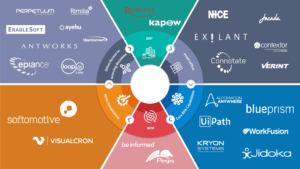Last updated on December 6th, 2022 at 05:27 pm
What is RPA?
Robotic process automation (RPA) is a type of automation technology that uses metaphorical software robots (bots), or artificial intelligence (AI). RPA robots use the user interface to manipulate applications and capture data just like humans.
What makes RPA (Robotic process automation ) different from other enterprise automation tools like SAP?
- Fast benefit realization
- Minimum upfront investment
- There is no disruption to the underlying systems
- The business should be led with support from IT
- Highly scalable solutions to improve the business environment
Why Robotic process automation (RPA)?
Let me give you an example in the banking section. The bank was concerned about the increasing number of fraud cases. Technology has only made fraud more common. Banks find it difficult to manually identify fraud patterns and verify every transaction. RPA employs an "if-then" method to identify potential fraud and flag it to the appropriate department.
How RPA works?
RPA robots are like industrial robots that transformed factories. It automates employee actions such as opening files, copying and pasting data, and replicates the inputs of employees. These are the two main categories with their respective features.
1.The bot is the unit for automation
Integration of the enterprise app with the bot
The programming interface is used to program the bot. It is relatively easy compared to other programming architectures.
2. Orchestration modules allow for the management of bots
- Handling business exceptions
- Different user access levels
- Analytics capabilities
Who makes RPA software?
The pros and cons of RPA
Pros :
- Increased Efficiency -- Bots can be used in conjunction with the automation process to improve efficiency.
- Higher Productivity -- Because efficiency has been improved, the production rate can be higher than in earlier stages.
- Elimination of Human Errors - Most production errors are due to human error. These errors can easily be eliminated by using bots.
- Cost Savings -- Because efficiency is higher and errors can be eliminated, it's possible to save money.
- Lower Turnover
Cons
- Monetary Expense -- RPA's initial implementation can be very costly.
- Employee resistance -- Employees resist the idea of handing over their jobs to robots and bots.
- Low technical ability -- The employees lack the necessary technical knowledge to use RPA bots. It is, therefore, more difficult to share this information with employees.
- Redundancy
How to implement Robotic process automation (RPA)?
Implementing RPA is easy if you have a clear roadmap. RPA deployments typically take less than two months, as you can see. This includes the time needed to set up, test, and launch RPA bots into production.
This implementation process can be guided by 12 steps.
You can maximize the impact of RPA by identifying processes that are most likely to yield the greatest benefits when they are automated.
There are some processes that RPA can automate.
- Management buy-in
- Team buy-in
- Convince functions
- Improve the process
- Select your partners
- Develop your solution
- Test your solution
- Run a pilot
- Go live
- Keep the RPA installed
(1) To maximize the impact of RPA, find processes that can yield the greatest benefits when they are automated.
These processes can be managed.
- Both revenue and cost impact: A quote to cash can have a negative effect on both costs and profits if the pricing rules are unclear. Sales can be broken by a fast and efficient quote to cash process. These processes make good candidates for RPA.
- High volume: RPA has the main benefit of reducing human effort. It is recommended to use RPA for high-volume processes.
- Fault tolerance: Any process that cannot handle errors should be automated.
- Automation can reduce errors - Companies can reap more from processes that are more manual.
- Speed sensitive: Customers who are experiencing delays in their orders are good candidates for RPA, as automation can speed up processes.
- Requiring irregular labor: Sometimes fining regular labors are hard. Companies are often forced to hire for inefficient peak demand because of irregular labor requirements. RPA bots can be used in such situations. RPA bots are able to scale up or down to manage peak demand.
(2) Choose processes that RPA can automate easily
These processes can be managed.
- Rule-based: RPA bots need to be programmed. Unprogrammable rules do not make a good candidate for RPA. AI can be used for complex rules training and uncovering rules.
- Except for a few exceptions, this is the same as before. RPA candidates should not be exposed to undocumented or covered rules.
- Mature: RPA is not a good choice for automation processes that are rapidly changing. These can lead to time and cost overruns. The RPA is best suited for stable processes.
- Not-candidates are processes that have been selected. These sub-processes can also be broken down and can yield great benefits through automation.
(3) Management buy-in
You can make a persuasive case for your company's leadership by understanding the automation process and potential benefits.
(4) Team buy-in
This implementation is very different from in-house and outsources processes. Outsourcing processes are often made more efficient by companies. However, the internal processes can be more complicated. Nobody wants to find out that their job is obsolete one day.
IT/technology is the most important stakeholder. IT should approve major tech purchases from a technical perspective.
- RPA Center of Excellence: Large organizations have established centers of excellence in RPA. RPA projects would require the involvement of CoEs.
- Data/Analytics - Bots leave traces for each action they perform. RPA teams can save a lot of time and headaches by working with the data/analytics team to ensure bots produce valuable, easy-to-use data.
- HR: RPA will play an important part in your company's success. It is crucial to train employees on RPA.
(6) Make the process more efficient
- Before you proceed with RPA implementation, it's worthwhile to examine the process for improvement. Process improvements are possible.
- Simplify the process
- Make it easier to understand, thereby reducing the need for programming and auditing.
- Improve customer experience
(7) Select partners
RPA technology is constantly changing and new solutions are being developed. It is important to take the time to review all aspects of RPA before you buy a solution. You need to choose an RPA technology provider.
(8) Develop your solution
Recent developments include the launch of RPA Marketplaces, which offer reusable plugins/bots that facilitate RPA development.
(9) Test your solution
Before the pilot can fly, it is important to test all major scenarios. You can test more realistic scenarios by using historical data.
(10) Run a pilot
The pilot should set targets: These could include accuracy or automation.
You will be running a live pilot. Each day, the team responsible reviews a random selection bot output.
Pilot results should be evaluated. This includes a thorough evaluation that takes into account rare cases and complex inputs. Finalize pilot only after previously set targets have been met.
(11) Go live
Design the governance for a new bot-driven process
Clarify your roles and responsibilities
Create a fallback strategy -- If the RPA solution needs to be reworked after rollout, a fallback strategy will help.
Go live -- Share the process with all stakeholders and go live!
Analyze the results -- Save money and analyze your results
(12) Keep the RPA installed
You will need to adapt your processes in line with regulatory changes and market changes.
By Ayesha Jayasankha
Read More:
- Social Media | Advantages and disadvantages
- AI (Artificial Intelligence) – Impact on Social Life
- Whatsapp Web: User guide | How to use whatsapp web Jk news magazine









